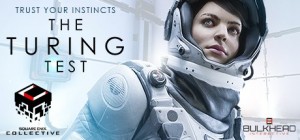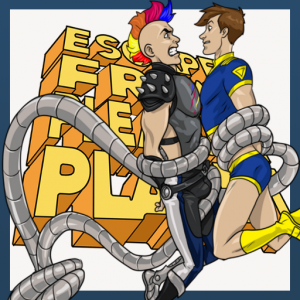Review for The Turing Test page 2
The words “first-person shooter” used to be anathema to many adventure gamers, what with the tendency of games like Doom, Quake and their progeny to emphasize frantic action, explosions and often mindless bloodshed. But then Portal came along a decade ago to arm the more cerebral gamer and show us that guns don’t make transportable rifts in space, people do. Yes, equipped with a very special kind of ammo and a more thoughtful mandate, we learned that weapons could be used to solve tricky environmental obstacles as well, fighting not for peace, just peace of mind. Other games have picked up the gun-toting-puzzle-solving mantle since then, but arguably none have ever bettered it (other than Portal’s own brilliant sequel).
The latest such challenger to the story-driven physics puzzler throne is The Turing Test, a game that wears its inspiration proudly on its sleeve. It’s thoroughly derivative in every respect, except for its own gameplay gimmick around which the entire experience revolves. That’s not necessarily a bad thing, as there’s something to be said about honing a tried-and-true formula if executed properly. And for the most part this game succeeds in delivering an engaging problem-solving experience, provoking thought on two levels at once, though its sci-fi story seems ill-fitted to the actual on-screen events, and its central mechanic wears out its welcome before the end of its substantial 8-10 hour play time.
The Turing Test is named after the trials of its protagonist, Ava Turing, but her name, in turn, is really a nudge-wink allusion to Alan Turing’s famous test of a machine’s ability to think and behave like a human being (or to be more precise, a test of whether a human can tell the difference). This theme is prevalent throughout the game, as it continually explores the notions of morality, free will, logic vs. emotion, and self-preservation vs. the greater good. While this is interesting enough as an intellectual exercise, it’s surprisingly disconnected from the actual gameplay on anything but the most superficial level. The discourse between human and A.I. was vital to the Portal experience, but here it’s mainly narrative white noise, affecting nothing tangible until an easily predictable “twist” in the middle and finally a confoundingly absurd endgame scenario.
Players control Ava, an engineer for the International Space Agency who is awoken early from cryosleep aboard a ship orbiting the research station on Jupiter’s moon Europa. All communication with the ground crew has ceased, and the facility’s artificial intelligence T.O.M. (Technical Operations Machine) sends Ava to the moon’s surface to investigate. Once there, she quickly discovers that the entire base has been reconfigured into a series of sixty-plus obstacle courses – challenges that can only be completed by a human being, not a sentient machine. This is your test.
Over time, the questions of why the crew has gone to such measures and why T.O.M. needs Ava to be his physical representation are touched upon, but never truly justified. The former is nicely explained in a way that should make you ponder questions with no easy answers, only to render it irrelevant at precisely the point it matters most. To its credit, the game also makes an attempt to rationalize its lab-rat setup, just not convincingly. For one thing, the sheer enormity of the complex precludes a small team of scientists from achieving such a construction on their own, but more importantly, we’re told that these are puzzles that can only be solved with creative thinking a machine is incapable of. Plausible theory, torpedoed by the fact that nearly every obstacle is overcome by making thoroughly logical connections between mechanical operations. In fact, I’d wager money that a machine could come up with solutions to each puzzle way faster than a person could. Really the sole purpose for your presence comes down to one simple fact: Ava has hands and feet, and T.O.M. does not. Saying that would have saved a lot of inconsequential chatter.
So okay, the thin premise doesn’t hold up, and the whole man vs. machine thing proves to be nothing more than a stimulating philosophical backdrop in the end, but really the puzzles are what The Turing Test is all about. I’m tempted to say that the result is a mixed bag, but in truth the only problem is that the bag doesn’t have enough to mix. Oh, there’s no shortage of quantity, but every single stage depends on one particular conceit: transferring energy from one end of a level to another. Energy comes in two different forms, module blocks that can be picked up and carried, and balls that can be shot and remotely retrieved from your gun. You’ll find various obstacles blocking the way and gain access to a few other room-specific tools, and often these are repackaged in clever ways as you progress, but there’s definitely a sense of déjà vu before all is said and done.
The tasks start out simply enough as you learn the standard controls, primarily WASD to move, left/right mouse clicks to fire/retrieve (or equally intuitive gamepad operations). Once you’ve mastered the basics in single small rooms, then you’re on your own to figure out how to power up light bridges, use levers to rotate columns, maneuver heavy ceiling magnets, weigh down pressure plates, remote-operate robots and cameras, channel laser beams, and synchronize hydraulic lifts, eventually spanning numerous rooms and multiple floors. Energy balls also come in three different flavours, each colour having its own distinctive characteristic. New hurdles are parceled out slowly but surely, so you shouldn’t ever feel too overwhelmed, but make no mistake: the difficulty does ramp up. A mechanical engineer could probably blow through them with ease, but I ended up looking at a walkthrough twice, so maybe I’m a robot after all.
Once the game has introduced its toys, however, the challenge comes from increasing and complicating the same elements rather than continually building upon them. In many ways, The Turing Test’s chambers reminded me of a series of environmental Tower of Hanoi puzzles. You know the one – where you need to shift a number of scaled rings from peg to peg to the opposite side without ever putting a larger ring over a smaller one, meaning you often need to take a step backward in order to ultimately move forward. Here you’ll frequently try to determine how to shuffle energy balls through receptors in the right sequence and right colour in the right places in order to proceed (after getting them there in the first place). Sometimes even your gun needs to be organized strategically, as it can stack up to three energy balls but must always have the right colour in the first slot to fire next. When coordinating your own position with a robot’s throughout certain courses, you become a Hanoi ring yourself by alternating movements appropriately. One time I triumphantly got myself to the end door, only to find out that I needed to get the robot there first. D’oh!
The big difference between a Hanoi Tower and The Turing Test, however, is that the latter can be done with all the pieces in arm’s reach. The game requires you to do rigorous legwork instead, and when the levels get bigger you can rack up some serious mileage going back and forth as you experiment. One mistake in your sequence may require stripping it all back down and starting over from the beginning. Even when you have a good idea of how to solve a puzzle, it can still take some time to physically implement it. This, as much as anything, is what finally drove me to a walkthrough both times. I simply got sick of all the wasted effort without knowing for sure I was on the right track. (Which sure sounds very human to me!)
While this game is fairly light in the platforming department, you will need an increasingly agile hand and sense of precision timing the further you progress. You’ll never have to worry about dying, even if you fall from a great height, but each time you miss a jump or mistime a very finicky staged sequence of movements with a conveyor belt or movable bridges, for example, you may find yourself having to start a whole series of steps all over again from scratch. There were only a few levels where I found this particularly frustrating, and even that just took a bit of practice to master, but those with less action game experience should consider themselves warned. Whenever you need to take a break, the game auto-saves between levels, so at least you can pick up where you left off easily enough.
It doesn’t help the lingering sense of monotony that The Turing Test never truly distinguishes itself visually. Like Portal, this game is set up as a series of linear rooms, but unlike Portal it really never breaks free of that confinement. In between the game’s seven main chapters you briefly get to explore common areas like the command center, crew quarters, and laboratory, and even foray once into the icy outdoors. These are welcome breaths of fresh air (in the one case quite literally) and offer the only opportunity to get to know your colleagues from their belongings left behind. But there’s nothing really to do here except snoop for a few moments and then move on to the next cold, clinical obstacle course before you. Only the odd (and totally meaningless) tint of coloured purple, green, or orange lighting ever changes the aesthetic at all.
The music is fine, ranging from strings and percussion to quiet, almost sad piano melodies and more blatantly sci-fi synth pieces. But it remains unobtrusively in the background, such that I barely even noticed if it was playing or not. Far more intrusive is the voice work, which is both a blessing and a curse. The droll British male voice of T.O.M. via intercom plays off nicely against the perky American Ava, and their dialogue represents pretty much the entire story, such as it is. Usually their exchanges begin in the hallways between test chambers, but they often carry on well into the next level, forcing you to either stop and listen or multitask and hope to absorb some of it osmotically. Given the non-casual nature of the topics being discussed, the former is probably advisable, even if you feel anxious to simply get on with the puzzle at hand.
The ending is actually fairly dramatic and could have made for a powerful finale, but its bungled delivery is completely misguided. I can’t say more without giving it away, but suffice it to say that it shockingly forgets the most fundamental point of the game right at the moment of truth. And even with three possible means to approach it, the only outcome is an unceremonious exit to the world’s slowest credit sequence. What a letdown.
Ultimately, The Turing Test succeeds far more as a pure puzzler than as an “adventure game” with a properly integrated narrative. It scores marks for trying, but other than the one obvious twist and endgame disappointment, really you could play with the sound off and probably not notice it was missing, such is the practical insignificance of the story. The puzzles themselves, though they suffer a bit from excessive padding before the end, are enticing far more often than not – complex enough to be challenging, but always logical enough to work out with a little thought and elbow grease. It’s not quite good enough to truly be a Portal “clone”, but for a would-be imitator with its own gameplay gimmick, it’s probably worth a look if you’ve got the energy and the will.



























